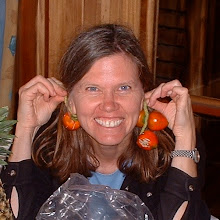Yesterday we went to a new reserve in Monteverde called Curi-cancha. They don't have a web site yet, but you can find them on Facebook. The walk started out with the exciting spotting of a Red Brocket Deer (Mazama americana), an animal we had never seen before. Unlike the common White-tailed Deer we see so often in Wisconsin, this deer freezes completely immobile for several minutes when it feels in danger. That made it an excellent photo subject.
Within minutes we were watching a group of six Golden-browed Chlorophonias (Chlorophonia callophrys) in a single tree. We've never seen so many of this pretty little bird in one place. They were hopping about quite excitedly, so I was delighted that Mr. Rududu managed to get his photo.
A little farther along the trail, we saw our first Resplendant Quetzal of the year, a beautiful male. He wasn't quite as easy to take a picture of since he was high in a tree full of leaves.
It's easier to find a quetzal if you know where the fruiting wild avocado trees are. This quetzal was near a tree with fairly large fruit for a wild avocado. The layer of flesh is quite thin; the pit is very large. The quetzals swallow the fruit whole and then regurgitate the pit.
Later, a fairly large mammal crossed the trail. I didn't see it and Mr. Rududu only saw the tail. Looking it up later in The Natural History of Costa Rican Mammals by Mark Wainwright, he decided it was the tail of a large cat called a Jaguarundi (Herpailurus yagouaroundi). There's no photo of this fleeting experience so I'm calling it the tale of the jaguarundi. Maybe that's just because I'm extremely envious. We've been told they are common in the reserve and it is the most commonly seen wild cat in Central America.
It is always amazing to those new to tropical birding that it can be very difficult to see a parrot (or many parrots) in a tree when the air is filled with their raucous calls. Their bright green feathers make them very hard to see among the leaves. Even in this photos, it's a bit hard to see the White-front Parrot (Amazona albirons).
I'm really looking forward to exploring Curi-cancha Reserve more. Perhaps I will return with a tale.
Within minutes we were watching a group of six Golden-browed Chlorophonias (Chlorophonia callophrys) in a single tree. We've never seen so many of this pretty little bird in one place. They were hopping about quite excitedly, so I was delighted that Mr. Rududu managed to get his photo.
A little farther along the trail, we saw our first Resplendant Quetzal of the year, a beautiful male. He wasn't quite as easy to take a picture of since he was high in a tree full of leaves.
It's easier to find a quetzal if you know where the fruiting wild avocado trees are. This quetzal was near a tree with fairly large fruit for a wild avocado. The layer of flesh is quite thin; the pit is very large. The quetzals swallow the fruit whole and then regurgitate the pit.
Later, a fairly large mammal crossed the trail. I didn't see it and Mr. Rududu only saw the tail. Looking it up later in The Natural History of Costa Rican Mammals by Mark Wainwright, he decided it was the tail of a large cat called a Jaguarundi (Herpailurus yagouaroundi). There's no photo of this fleeting experience so I'm calling it the tale of the jaguarundi. Maybe that's just because I'm extremely envious. We've been told they are common in the reserve and it is the most commonly seen wild cat in Central America.
It is always amazing to those new to tropical birding that it can be very difficult to see a parrot (or many parrots) in a tree when the air is filled with their raucous calls. Their bright green feathers make them very hard to see among the leaves. Even in this photos, it's a bit hard to see the White-front Parrot (Amazona albirons).
I'm really looking forward to exploring Curi-cancha Reserve more. Perhaps I will return with a tale.











1 comment:
Almost missed him in the last photo! Brilliant.
Post a Comment